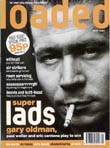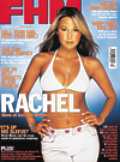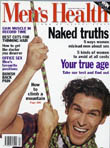Men's magazines: lads' mags
This is the second part of an article on men's magazines on four pages:Men's magazines I :
- Early evolution
- The accepted wisdom
- Exploring the gap
Men's magazines II – this page:
Men's magazines III:
- The advent of women
- A maturing men's magazine market
- Taking over the world
- Into the digital world
Men's magazines IV:
- IPC and Emap gear up
- Nuts – 'the world's first men's weekly'
- Emap follows with Zoo Weekly
- Building a new market -Cut and KO!
- Decline sets in
- A free way forward
- Table: Men's magazines: details and sales

Loaded: the original lads'mag |
Loaded: the lads' magLoaded was that rare type of magazine – it created a genre, lads' mags. In the process, it knocked other men's titles into a niche. It saw itself as 'the antidote to the snooty fashion-based publications of the time'. However, its publisher IPC failed to invest in the title and take it in to the international arena. Furthermore, one of the titles it at first eclipsed – FHM – was to bite back, albeit under a new publishing company.In May 1994, IPC launched Loaded. Its unselfconscious, irreverent style defined a 'laddish' culture that was ground-breaking and was to reverberate around the world. On television, the same laddish element was seen in BBC programmes such as the sitcom Men Behaving Badly, the sports quiz They Think It's All Over and the irreverent news quiz Have I Got New for You (in which one of the teams was led by Private Eye magazine editor Ian Hislop). Other TV presenters and stand-up comics were part of the trend that encouraged lads mags, such as Paul Merton and Frank Skinner (who was featured on the cover of issue 6 – 'Nudge, nudge, wink, wink: Frank Skinner's world of smut'). Editors are, by nature, individualists who tend to react badly to strait jackets. They will use their own language and terminology. In fact, it is their attitude and style that may be the difference between a top titles and an also-ran. Loaded's founding editor James Brown brought in attitude by the bucketful. His regular editor's letter was entitled 'page three', a reference to the Sun tabloid newspaper, which had become famous for its topless women on that very page. In the first issue of Loaded, Brown wrote: 'What fresh lunacy is this? Loaded is a new magazine dedicated to life, liberty and the pursuit of sex, drink, football and less serious matters. Loaded is music, film, relationships, humour, travel, sport, hard news and popular culture. Loaded is clubbing, drinking, eating, playing and eating. Loaded is for the man who believes he can do anything, if only he wasn't hungover.' Of course, this is too long for a front cover, so the defining lads mag portrayed itself as 'For men who should know better.' There were variations on this: 'For men who should know letter' for a July 1995 cover on David Letterman; and '...snow better' for the January 1995 cover showing Santa being knicked. The nature of its success can be seen in the sales figures. The first issue sold 59,400 copies and Loaded broke the 100,000 sales barrier with its ninth issue. Its first audited yearly sales figure was 96,000 - and this rose by 82% to 174,763 for the period Jul-Dec 1995. Loaded deputy editor Tim Southwell described the early days of lads mags in his book Getting Away with It (Ebury, 1998). |

FHM in December 2001  Men's Health first issue: a new type of men's magazine in the UK |
The rise of FHMAs IPC was preparing to launch Loaded, Emap bought the 76,000-circulation fashion title FHM (formerly For Him) from small publisher Tayvale and Mike Soutar set about the relaunch with publisher David Hepworth. He developed ways of differentiating his lads mag from the then market-defining Loaded through taking a very practical approach. In his view, Loaded offered readers the chance to live life through the writers as they "drink and snort their way through endless freebies". Arena and GQ seemed "impossibly cool for the average bloke".He took Brown's philosophy, but added a dimension; everything in FHM had to be accessible to readers. In a Guardian interview (17 February 1997, page 7), he espoused a "mantra" that everything in the magazine had to be: "funny, sexy, useful". Writers could never cover any activities that readers couldn't also take part in. So phone numbers and addresses were to be found at the end of most articles. In retrospect, this sounds simple, but Soutar's relaunch was in a highly competitive sector, in which IPC, Conde Nast and National Magazines were already active. And more competition had arrived from Dennis's Maxim (Aug 95) – with Gill Hudson as editor – and Rodale's US-import Men's Health (David Hale, Feb 95), as well as Arena launching the bi-annual Hommes Plus as a spin-off, in effect going to eight issue a year. |
| Profile of men's magazines by mid-1996 | |||||
| Sales (ABC Jan-Jun 96) |
Age % 15-34 |
ABC1 Social grade % |
Male % | Single % | |
| Loaded | 238,955 | 92 | 73 | 81 | 76 |
| FHM | 181,581 | 89 | 70 | 82 | 69 |
| GQ | 131,074 | 81 | 75 | 79 | 62 |
| The Face | 112,227 | 91 | 72 | 64 | 72 |
| Esquire | 107,058 | 78 | 81 | 74 | 58 |
| Arena | 93,513 | 88 | 68 | 77 | 75 |
| Source: Loaded media pack, 1997 Go to Page 3: The advent of women |
|||||



